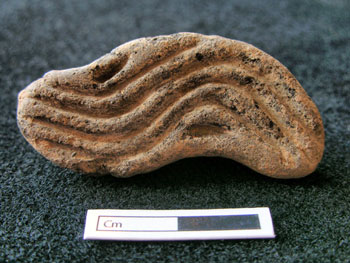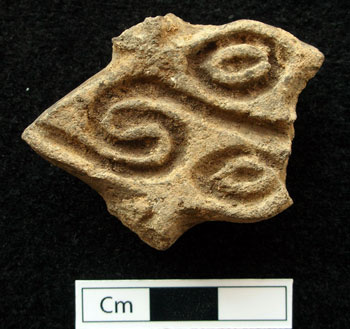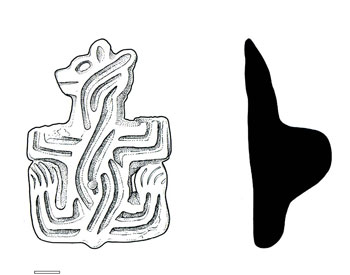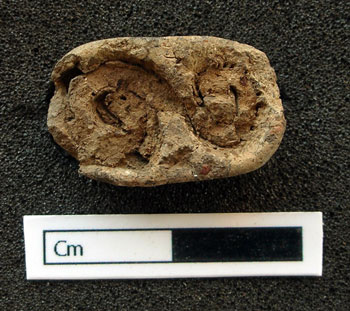ÇATALHÖYÜK 2005 ARCHIVE REPORT
| |
CULTURAL AND ENVIRONMENTAL MATERIALS REPORTS
Clay Stamp Seals
Abstract
The numbers in seals is increasing with the momentum since. However, these results are not coincidental, rather depending on new macro scale excavation since 2003 and addition of one more new areas. Increasing number of stamp seals from every excavation section also reveal that the stamp seals were a common artefact group that had been widely used or manufactured in every parts of the settlements and probably most households of Çatalhöyük.
Eight stamp seals were recovered during the 2005 season. Stamp seals (5 of 6 seals) were recovered in the areas of 4040 (north), Summit and the recent exposed Istanbul (Ist) area. Combined with last season’s recovery (Türkcan 2003), the 4040 Area is still giving many examples as in two years. All those found in 2005 are made of clay and majority seems to be baked. Three seals are from the 4040, three seals are from the Summit and two seals are from IST.
An exquisite seal (11652.X1 , Summit). with an bear representation became one of the focus of 2005 research. And put forward a new discussion about the symbolic identities of the representations. It is the first presentation of a different mammalian that is not ever seen so far in stamp seals as well as in other Çatalhöyük representations (wall paintings, figurines). However, as stated in Press Release 2005.
“These plaster reliefs (upraised armed human deity representations) have often been interpreted as ‘mother goddess’ figures. But the heads and hands of the plaster relief examples have always been cut off, so it was never possible to say whether the figures were humans or not. But now the stamp seal provides a key. Here the head and the hind paws remain. They clearly show that the figure is an animal, probably a bear. So it is probable that the reliefs with upraised arms and legs are not goddesses but bears. Depicting animals, such as leopards, in houses is common at Çatalhöyük, and so it is not surprising that we should find a bear”
The representations on the walls of (Temple?)VII.1, VII.31, VI.8, VII. 45. VI.B.8, VI. B.10 forces us to think that the bear presentation seems not to be reserved only to the stamps in Çatalhöyük.
Özet
2005 kazı sezonunda 8 tane mühür bulunmuştur. 1993 Çatalhöyük kazılarından bu yana en fazla bulunan mühür sayısıdır. Geçen üç sene zarfında buluntuların, diğer buluntular (örneğin figürinler) gibi her sene çoğaldığı gözden kaçmamaktadır. Bunun nedeni doğal olarak, 2003 senesinde başta çok geniş bir alanda (40x40 Alanı) başlayan makro ölçekli kazılar ve yeni alanların da buna eklenmesidir. Bu sene bulunan mühürlerin hepsi kilden yapılmış ve pişirilmiştir.
Bu sene bulunan sıradışı amulet tipinde bir damga mühür, 2003 de bulunan leopard mührü gibi Çatal Höyük Tasvirli sanatının ağırlığını oluşturan Duvar Resimleri ve Kabartmaları ile ikonografik bir parallelik içinde ortaklıklar gösterirken, bir yandan ÇatalHöyük Hayvan Simgeselciliğinin çözümünde önemli veriler vermeye başlamıştır.
12124.X1 (4040)
Non Complete (% lost?). H 0.95 cm, L 3.1cm, W. 1.5. Munsell 2.5 Y, 4.1 Dark Gray (Surface Color). 5.3/ 2.5Y light brown (Core Color). Medium To Well Baked. The broken piece seems to be a part bigger figurative formed stamp seal. The seal’s curving form and the grooved pattern are identical to each other. There are two grooves that recall toes at the edge of curving form.
10086 (Dry Sieve) (4040).
Clay. Non-Complete .H 1.8 cm, L4.7 cm, W. 3.3. Medium To Well Baked. Munsell 7.5 YR 2.5 Black (Seal Face). 10YR 4.1 Dark Gray (Handle). The seal face is oval. The seal face is burnished. It is noteworthy that seal face is not true flat but a bit concave towards the inner side (center). The seal face smooth surface has been burnished. The patterns have been arranged in a symmetrical order with curving patterns filling every space of the frame. The basic scheme is composed of two antithetical curve set diagonally up and down below the curve in the center.
11938. X3 (4040)
Clay. Non- Complete. Low Fired. H.2.3 cm, L 2.7 cm, W. 1.6.Half of the seal has been lost with the handle. The general design of the patterns is not understood well because of the fragmentation of the stamp. The general design scheme is an unsymmetrical arrangement of curving patterns. The patterns are grooved and getting especially deeper in the center.
11670. X6 (South, Building 44 & 56).
Figure 92. Clay stamp seal 11670.X3. |
Clay. Complete. H.2 cm, L 4.4 cm, W. 1.9. Munsell 2.5 Y, 7/4 Pale Yellow, 6/4 (Surface Color). Medium To Well Baked. 5.3/ 2.5Y light brown. The complete seal face form is curving ellipsoid that is also a common shape in the assemblage. The seal face is very flat. The seal face is composed of five grooved curving parallel patterns that are also identical to the seal face form. Two roundel grooves are set between the curving edges and the last curving linear pattern.
11632. X1 (South, Building 44 & 56).
Figure 93. Clay stamp seal 11632.X1. |
Clay. Non-Complete. H.1.2 cm, L 4.2 cm, W. 3.3 cm. Munsell 2.5 Y, 5.4 Light Olive Brown. (Seal Face). 2.5Y 6.4light yellowish brown (Back side), 2.5 Y, 4.1 Dark Gray (Core). Low to Medium Baked. There is slip on the surface. The seal had been very much damaged and worn away in some parts that the complete seal form cannot be distinguished. T he form seems to be composed of small projections with slight curve on their sides. Handle is broken and almost lost. The piece in such a condition seems to have been already discarded before its deposition. The seal face is decorated with three grooved spiral patterns of which one of them at the edge are set between other spirals.
11652.X1 (South, Building 44 & 56).
(Konya Museum Env. 16). Almost Complete (Figs. 2 & 33) . Clay. Low to Medium Baked. H.2.7 cm, L 6.6 cm, W. 4.6 cm. Munsell 2.5 Y, 6/4 Light Brown (Front Side Body), 10 YR 7/4 very pale brown (Front Side Head Part). 10YR 7/3 very pale brown (Back Side). This is the second amulet type stamp seal with the other (Leopard Seal) from 2003. Despite this extraordinary piece have been found with a minor damage of the forelegs, it is possible to identify the missed parts and to make a reconstruction of the overall form. The all paws below the head seem to have been intentionally broken on the same level. The small tail is also emphasized between the legs.
Figure 94. Drawing of clay stamp seal11652.X1. |
The overall form, the head, small tail and other features (the head and the paws) all shows that it is an bear representation. The design on the seal face is composed of double curving parallel lines confronting each other at the center (on the belly) and parallel curvings following the contours of the other body parts (forelegs, backlegs and head). One tint pebble is recognized as stuck just in the middle of the belly part. It makes a contrast with flat and smooth surface of the seals face side. It is also noteworthy that a similar spot is also emphasized on the bellies of upraised arm reliefs (in the spaces of VI 1, VII.31, VI.8, and VII. 45. VI.B.8, VI. B.10; see Meellart 1967). It is enforcing me to think the bera seal and the upraised arm figure reliefs seem to share the similar iconography.
This exquisite seal that recalls a royal signet, is so well designed that canons of every part have been balanced and also harmonized with the curving patterns on the seal face. Moreover, the naturalism of the details especially as seen in the head and paws, toes are also noteworthy. Therefore, the exquisite seems to be an artisan work as indicated in many of the seals.
By the way, the study on the Mellaart assemblage in 1997, one hand shaped seal with larger and bold toes in oval form was already distinctive (Level IV, Area E1; Mellaart 1964: Fig.41.4), so it had been considered as a paw as well as a human hand (Türkcan 2005; Seal No. 19). In earlier research, I am hesitant to say it was a bear paw, but, in the light of our bear representation, now it can be called as bear paw.
11849. X.17 (IST).
Clay. Non-Complete. Low to Medium Baked. H.3.1 cm, L 5.2 cm, W. 2.6 cm. Munsell 2.5 Y, 4/2 Dark Grayish Brown (Backside). 10YR 4/1 (seal Face). 2.5 YR 6/2 Light Brownish Gray (Backside). The seal face was oxidized due to firing. In contrast, the backside with the handle is not oxidized. Actually, this mottled surface on the seals is not a rare thing among the stamps. This is probably due to their positions during firing as one side is exposed to firing, other one is not (according to their positions during firing). The Some part of the seal (along one edge of the seal) is very much worn away and abraded. It seems to have been already discarded when it was deposited. The seal face seems to be divided into two zones by a grooved line at the center. The sides are composed of grooved curvilinear designs with a loop at their ends.
11858. X2 (IST)
Figure 95. Clay stamp seal 11858.X1. |
Clay. Complete. Low Baked. H.1.6 cm, L 1.8 cm, W. 1.1 cm. Munsell 2.5 Y, 4/2 Dark Grayish Brown (Backside). 2.5Y 4/4 Olive Brown (Core Color). Burnished. The complete seal face form is oval. Some tiny pores can be distinguished on seal face as vegetative inclusion remains. The surface is crunchy because of low baked or maybe not baked. T he seal face pattern is composed of two broad spiral patterns following each other. The center of grooved patterns has been cracked into 3 mm. Deep.
| |
© Çatalhöyük Research Project and individual authors, 2005



